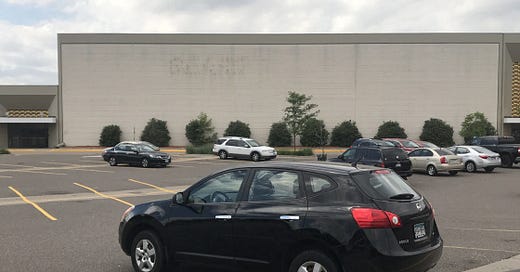The following was originally posted in November 2019 on Medium.
It’s called Retail Apocalypse.
Since at least 2010, a steady number of businesses have disappeared from the marketplace. Brick and mortar stores, actual locations, are shrinking in favor of online shopping. Most people blame one online retailer in particular: Amazon. It has revolutionized shopping, moving people from physical places to the store that is on your computer screen. Of course, this has had an effect on retail. Stores like Borders that were slow in getting online, ended up going out of business. This is capitalism at work: innovate or die. If you play it safe, you might end up on the trash heap.
Capitalism, when it’s working well, should be about risk. Companies try different strategies to sell their widgets and become profitable. Companies have to find ways to be relevant. But of course, there are those that want to game the system. They aren’t interested in trying to innovate. They look at making money and they socialize the risk in order to reap the benefits. They take a risk and others pay the price. You don’t have to be a socialist to think something’s wrong in that equation.
Sears and Kmart merged in 2005 and since then the two retailers went through a slow-motion liquidation. Each round of store closures makes the once-mighty Sears smaller and smaller. Instead of all happening at once, it is happening a little at a time. The last Sears store in the state where I live, Minnesota, closed this past spring. In a few months, the last KMart in the state will be in Minneapolis.
On the surface, it seems like Sears is just another casualty of Amazon. Sears didn’t innovate and it is facing the consequences. It’s part of what is capitalism.
But that’s not what is happening. The slow death of Sears and Kmart wasn’t a foregone conclusion. It never has been. It’s true, both stores were not in great shape at the time of the merger. But the reason we are seeing the slow collapse of these once august retailers is not because of Amazon. If it was, Sears’ downfall would not hurt so much. The downfall of Sears and KMart is the fault of one man, and it’s not Amazon head Jeff Bezos. Instead, it is an incompetent and greedy hedge fund leader that caused stores to shutter and left thousands without jobs. It is a reminder of how messed up American capitalism is these days.
I am talking about the current CEO of Sears Holdings, one Eddie Lampert. Lampert is the epitome of someone who doesn’t put his own skin in the game. Sears would not be in the desperate position it’s in if not for the malpractice of Lampert. Maybe it would have faced bankruptcy, but not in the way it did under Lampert. Last fall, Ethan Epstein described Lampert to a T in the Weekly Standard:
If Warren Buffett is the cuddly grandfather of American capitalism, investing in solid, well-managed businesses so they can prosper in the long run, Lampert is the sleazy uncle who shows up to the family reunion each year with a different girlfriend and new sports car.
I wrote about Lampert’s mismanagement a few years ago. Lampert is not the type of guy that wanted to make Sears and Kmart profitable. He wasn’t interested in helping Sears make it in the 21st century. Instead, he stripped the company of its value. Like Toys R US before it, Sears is the victim of “ Vulture Capitalists.” Over the years, Lampert talked about a turnaround, but there was no new strategy ever materialized. He would meet with the company board via teleconference from one of his homes in Connecticut, rarely bothering to come to Sears’ headquarters outside Chicago. He never spent money -skin in the game- in trying to modernize stores, so they started to languish. Sears and Kmarts became sad and forlorn places. This story from CBS News shows how terrible Lampert’s leadership was:
Lampert, a devotee of the novelist Ayn Rand, reportedly made division heads compete for resources and money, believing that the competition would ignite innovation and sales. Instead, At the store level, shoppers weren’t happy, either. Sears failed to upgrade stores and keep shelves stocked with enticing merchandise, leading to customer defections. to Bloomberg, the result was managerial infighting.
The kicker of the article states that Sears, once a trusted name, became dirt. In 2016, women shoppers had given up on the brand and preferred to shop at Goodwill. Yes, Goodwill. When a thrift store is beating Sears, you know the situation is terrible.
Is Lampert incompetent? Yes. But it really wasn’t simply incompetence. Sure, Lampert is a terrible CEO, but he is savvy enough to make money from Sears’ fall even as people were losing jobs at Sears and KMart stores. A CNBC report from 2017 explains:
USA TODAY estimates that the value of Lampert’s Sears stock has declined by roughly $519 million since the end of 2014. That estimate was derived by calculating the value of his Sear’s holdings at the end of each year since 2010, using Sears closing stock price for the year and the number of shares Lampert owned at the time, culled from S&P Global Market Intelligence data. Using that methodology, the highest year-end value of Lampert’s Sears holdings was $760.3 million. But Lampert won’t lose it all. “If they go bankrupt, he remains in control of the company because, though he loses his equity stake, he’s their principal creditor,” former Sears Canada CEO and Columbia Business School Professor Mark Cohen said an interview. But Lampert has cordoned “off an enormous amount of assets through the loans he’s made, which have essentially protected him from what is eventually (going to) occur.” He has spun off divisions, provided secured financing in exchange for real estate collateral and transferring valuable properties to an investment trust, all while retaining ownership stakes in those assets.(emphasis mine)
But did it have to end this way? No, it didn’t. As Helaine Olen wrote in the Washington Post when Sears filed for bankruptcy last year, Sears could have had a future. She holds up the example of Macy’s to show that companies can turn around if those in charge give a damn:
Macy’s, which is older than Sears and was also considered a dead retailer walking less than five years ago, has seen sales rise following investment in sprucing up both its stores and Internet presence. It took Lampert to take Sears, a company that was a fading but still viable middle-class emporium, and over a decade turn it into a rich man’s play thing, his own personal great white whale. About 200,000 positions were lost as Sears cut back time and time again, but Lampert, as largest shareholder, remained on the job.
Lampert wants to make money which is part of the problem. Making a profit isn’t bad, that is the glory of capitalism. It’s when you want to make a profit at the expense of others. Lampert isn’t earning the money; he isn’t working for that profit. Instead, he did the bare minimum to reap big rewards.
The Sears of old was able to make a profit and undermine Jim Crow in the South. They were willing to risk profit for the greater good.
If you want to see where Sears is thriving because the owners invested, you have to go South of the border. While it shares the name of the American retailer, it is owned by Groupo Sanborns, which is owned by Carlos Slim, the Mexican billionaire that has been considered off and on, the richest man in the world.
The difference between the two chains is the difference between an owner that cares about the company and one that seems to either not know what he’s doing or doesn’t care.
According to Bloomberg, Sanborns owns about 100 Sears across Mexico and which includes three brand new stores and plans to remodel a number of others. Sales are a mixed bag, but on the whole, positive:
In the second quarter of 2018, Sears sales declined 0.9%, according to the company’s financial report, whereas Liverpool’s sales went up by 7.4% in the same period. Nevertheless, Hermosillo explained that the chain generates around 50% of all income for Grupo Sanborns, one of several subsidiaries under the Slim-owned Grupo Carso umbrella. The former has invested around 2.3 billion pesos (US $122 million) this year and by the end of this year is expected to have opened a fourth new Sears store. In an attempt to boost sales and better compete with its rivals, Sears México is also updating its image by increasing promotion of its fashion lines rather than home appliances, furniture and hardware as it has traditionally done.
You keep hoping that someone will step in and say “enough.” You hope that someone would buy out Lampert and others and try to rebuild from the shambles. You hope that Lampert and others would at least lose some money. But it won’t happen.
Something is off here in America. Unlike Mexico, we don’t seem to have business people that actually want to earn their profit. What we have are people like Lampert, who are more interested in making money at no risk to themselves, just let the little guy face the consequences. He doesn’t want to put skin in the game.
I truly believe capitalism can and does lift people out of poverty. It has done that around the world. But capitalism can be deformed. It can be used for selfish purposes instead of for the common good.
What’s happening with Sears is a microcosm of what people think is happening in America. It is harder and harder to maintain a middle-class life, while those who are blessed with riches, tend to find ways to risk other people’s lives. They want the glory as long as they escape the cross.
Sears is testing a few new stores in different locations across the country. But will it work or is it just smoke and mirrors?
On an alternate Earth, Eddie Lampert would be celebrated as the man who turned around two well-known brick and mortar stores to compete in the 21st century. He would have restarted the Sears’ catalog business which would have rivaled Amazon. He would have made Kmart a successful “middle way” discount retailer between the shabby chic of Target and the bargain discount of Walmart. Both stores would see an uptick in businesses after he spent millions updating stores. Lampert could have taken a risk in trying to make Sears and Kmart hip, and it would have ended in a big payoff for him and his workers.
But that is not what it’s like here on Earth 1. Instead, we deal with an owner that gambles with other people’s lives and manages to win at their expense.
Maybe that’s why politicians like Elizabeth Warren are so popular. Warren called out Lampert earlier in the year. I think she is too radical, but looking at people like Eddie Lampert helps me understand why there is an Elizabeth Warren out there.
It didn’t have to be this way. But Eddie Lampert made sure that Sears would die an ignoble death while he walks away with no scars.
One day Lampert will face a reckoning, but that will only happen years down the road, after he destroys one of the best-known retailers in America.
He won’t pay a price for what he did to Sears and thousands of its employees.
Amazon didn’t kill Sears. That was done by Eddie Lampert. The killer is getting away with it.
Who Killed Sears and Kmart Series:





